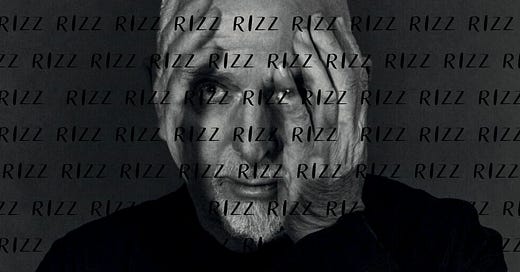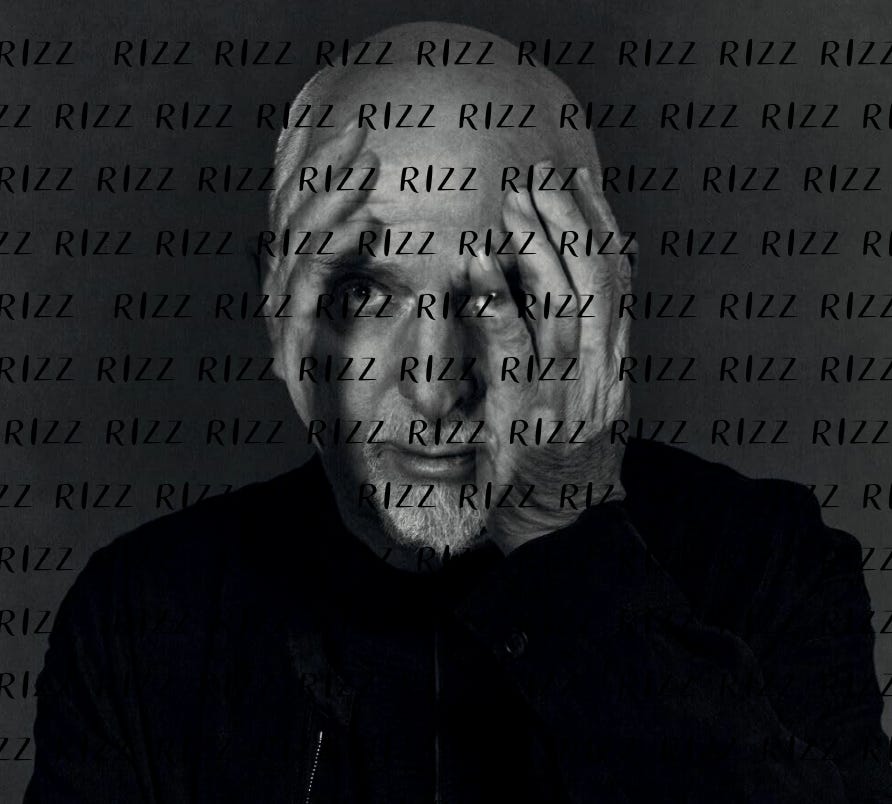Rizz, Belief, & Peter Gabriel, i/o
Oxford turns us all into rizzaholics & seeing is not believing
A Word Climbing the English Language Charts—Rizz
It’s akin to Christmas morning at Oxford Languages, the day the word of the year is announced. Everyone’s excited to unwrap the big one.
This year’s winner was measured by a team of language experts and more than 32,000 votes from the public.
As many of you wordheads already know—as it was all over “the news”—this year’s winner was:
Oxford says the term rizz stems from the middle of the word charisma, much like fridge and flu can be found inside refrigerator and influenza.
Aren’t words fun and rizzy?
Among the finalist were the words: prompt, situationship, and swiftie. O’ Taylor, we love thee.
The shortlist also included: beige flag, de-influencing, heat dome, and parasocial.
Just so you know where we are coming from, Oxford’s #WOTY2022 was Goblin Mode.
Rizz is considered a Gen Z term that in one quick year, grew from a Johnny Apple Seed into an entire orchard spread across the English speaking world.
While generally a noun, rizz also gets active in its verb-phrase form: rizz up—meaning to attract or chat up a person.
It’s also possible to have unspoken rizz, referring to the subtle charm possessed by one without speaking; and the noun form, rizzler, someone who has exceptional amounts of rizz—basically a pickup artist.
BTW- Rizzler has nothing to do with Twizzler … not yet!
While Merriam-Webster included rizz on its list, they awarded authentic with first place.
Aren’t these two words 2nd cousins anyway? Because you’ve got to have rizz to be authentic.
Here are 3 other slang words rising in the charts:
Bussin: Really good, usually describes food or style
Sigma: a stoic guy
Sus: Suspicious or suspect
Here’s a sentence using all three slang words and rizz together—watch out, this one bites.
That sigma’s got so much mad unspoken rizz it’s straight sus when he wears something as un-bussin as those acid-washed blue jean overalls from the Gap circa 1991/92.
Something I wish, in its brightest form, for everyone—Belief
There has been a lot of talk in my home this year about belief. Vera is wavering in her faith towards Santa. Lots of questions. Lots of logic and kid smarts. And a lot of “I want to see him.”
Years back, I wrote this little article on the origin of Santa Claus for Middle Land Magazine.
Perhaps there is but one important thing to know. Santa grew from a seed of compassion—he sprouted from a single act of giving. And so did his mission: to give of himself to others for the rest of his life. Actually, this is the mission of a saint.
from Santa Claus and the Seed of Giving
While in all likelihood there was a historical Saint Nick, who was so selfless in his giving, he saved others from destitution—this inner-nature is an embodiment we can chose for ourselves, and it doesn’t have to only happen at Christmastime.
While some may question our parenting, we watched the entirety of Ted Lasso with our kids. They loved it. We loved it, watching it beside them, warming us all up just as if we were sitting beside a crackling fire.🔥
The whole world loved Ted: his warmth, how it spread.
All the characters in the show had their hearts melt when in his presence. Or they wasted some time attacking him first, until they eventually fell prey to his unshakable goodness, and then their hearts melted.
While Ted Lasso is a fictional character, his innocence, humor, and kind, kind heart are contagious entities that exist in the real world.
Like a virus, you can catch “it” just by being around “it.”
But believe me, this form of Santa is a sickness you want to catch.
Get around some authentic compassion and❤️🔥❤️🔥❤️🔥 = melt.
That’s what we do each December. We all catch a serious case of the Santas. It’s a very real condition.
Having a sense of humor doesn’t hurt either. Say Ho Ho Ho out loud 75 times or until you faint.
"I believe in Communism. Rom-communism, that is. If Tom Hanks and Meg Ryan can go through some heartfelt struggles and still end up happy, then so can we."
—Ted Lasso
There’s a Ted Lasso T-shirt out there that says it best “I Believe in Believe.”
I don’t wear the shirt, but I, sure as Santa, believe in believe.
I hope you do, too.
What I’ve been listening to for the last week—Peter Gabriel’s, i/o, his tenth studio album
If i/o shows anything, it’s that Peter Gabriel is a man of mad unspoken rizz.
At the ripe-young age of 73, he puts out a life affirming album—but not without its societal critiques—that breaths its spirit into sonic form, and speaks about life’s interconnectedness.
It’s in his sound; it’s in his lyrics—this is the Peter Gabriel fans have grown to adore, but all over again, in a fresh, authentic form.
The choruses in i/o are addictively melodic, and are as bright and punchy as his classics from the 1986’s hit album So.
In fact, i/o just hit number 1 in the UK, 37 years after So topped the chart.
A true creative at work, Gabriel’s i/o encompasses 12 songs presented in their “Bright Side Mix,” and the same 12 songs to follow in their “Dark Side Mix,” with subtle differences.
The title track i/o, gets its name from the world of computing, where it means input/output. Here Gabriel explores how we are all part of the earth’s constant flow—input and output, life and death, “stuff coming out, stuff going in.”
The lyrics in the song, and across the album, are rich and filled with narrative about nature, Earth, joy, life and death:
We all belong to everything / to the octopus’ suckers and the buzzard’s wing / to the elephant’s trunk and the buzzing bee’s sting
While so much of the album sprouts from Gabriel’s wisdom accumulated over 7 decades of life on planet Earth, he also appears critical, sus, of what society has become, so dependent on our own wonderfully scary creation: technology.
The song The Court says:
You got money going up your nose / you got the data, don’t control where it goes / what you have left is getting down to the bone / your only memory’s on your mobile phone.
And later in the song: we lost the line between the sane and the mad / still draw the line across the writing pad.
Basically he’s saying we humans have all entered goblin mode and fiddle with our devices too much, disconnected from what is real.
Gabriel has explored this territory before with the theme song for Pixar’s Wall-E, Down to Earth.
I asked Solomon for his take on the differences between the “Bright Side” and “Dark Side” mixes, and here’s what he had to share:
The Bright Side mixes feel much more radio ready; the instrumentation is clean and crisp, plus each track is given plenty of space to rest within the stereophonic spectrum.
The Dark Side mixes are much more muddy, with their washed-out drums and layered synthesizers/strings. Each instrument has less room to breathe and is constrained into more of a box-like shape.
My one sentence summary on the different mixes is this:
listen to the bright side during the day; listen to the dark side at night.
🎧⬇️🎧👍
Don’t miss these 3 songs: i/o (Bright Side), Road to Joy (Dark Side), Live and Let Live (Bright Side)
➡️📏➡️ i/o Rating: 8.7 / 10
Weekly Word
Thank you Peter for 1.) being such a straight bussin guy; 2.) for inspiring this weeks weekly word.
The name of the leading song on i/o sure makes you curious about what it means:
Panopticom—
From one of Gabriel’s early i/o releases: “The first song is based on an idea I have been working on to initiate the creation of an infinitely expandable accessible data globe: The Panopticom. We are beginning to connect a like-minded group of people who might be able to bring this to life, to allow the world to see itself better and understand more of what’s really going on.”
While at first this might sound far fetched, if you research Witness, a human rights organization co-founded by Gabriel, you’ll catch on pretty quickly he’s serious.
This one is a rabbit-hole. But … since we are already part way down it.
In the following deep-dive video into the song and concept behind it, Gabriel mentions that Panopticom is really an evolution of Panopticon.
Panopticon—
from the Cambridge dictionary:
a prison with cells (=rooms) arranged in a circle, so that the people in them can be seen at all times from the center.
This concept was masterminded by the English philosopher and social theorist Jeremy Bentham in the 18th century.
Used in a sentence: I’m going to script an Orwellian melodrama that takes place inside a panopticon about a bunch of parasocial prisoners and one prison guard with a samurai sword who is super sus.











